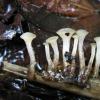
15-12-2025 15:48
 Danny Newman
Danny Newman
Melanospora cf. lagenaria on old, rotting, fallen

15-12-2025 15:54
 Johan Boonefaes
Johan Boonefaes
Unknown anamorph found on the ground in coastal sa

15-12-2025 21:11
 Hardware Tony
Hardware Tony
Small clavate hairs, negative croziers and IKI bb

15-12-2025 07:09
 Danny Newman
Danny Newman
indet. Rutstroemiaceae sp. on unk. fallen leavesMc

15-12-2025 07:05
 Danny Newman
Danny Newman
Pseudosclerococcum golindoi (det: Zotto)near Cosb

15-12-2025 11:49
 Danny Newman
Danny Newman
ITS sequences from the following two collections B

15-12-2025 12:34
 Danny Newman
Danny Newman
indet. Rhytismataceae on oak leafnear Purchase Roa

09-12-2025 12:06
 Andgelo Mombert
Andgelo Mombert
Bonjour,Je recherche l'article concernant Hypobryo
??Dear everyone.
This discomycete, frequently found in Japan, seems to be identical to Cudoniella clavus in macroscopic, microscopic, and ecological characters.
According to Dennis, etc., ascus pore of C. clavus is non-amyloid, but this ascus pore turns blue by IKI, more clearly with KOH pre-treatment. (I have no microphoto)
Is it true C. clavus?
Masanori Kutsuna

In Huhtinen 1985: 511 (mycoflora Poste-de-la-Baleine?) the reaction is clearly blue after KOH. Also In my collections I saw repeatedly a distinct blue reaction in IKI (Hymenoscyphus-type).
However, at least in one (HB 1000, from Black Forest) ?I noted IKI-. This explains why authors like Dennis, Breitenbach & Kränzlin or Gamundi 1998: 114? likewise found inamyloid asci.
Zotto?
Thank you for the answer.
Let me ask you a question.
If so, what is the difference between Hymenoscyhus and Cudoniella?
Regards,
Masanori Kutsuna

Zotto
Regards,
Kutsuna
